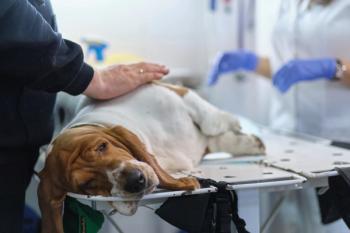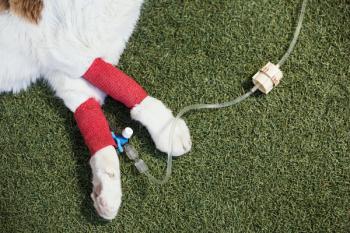
It's time to raise bar on hygiene, study says
Veterinarians "in general have a roguish attitude" toward protecting themselves against dangerous infections and zoonotic diseases.
Atlanta — Veterinarians "in general have a roguish attitude" toward protecting themselves against dangerous infections and zoonotic diseases.
That's the word from a veterinarian at the U.S. Centers for Disease Control who helped conduct a major study of infection-control practices within the profession.
"I can't say we were overly surprised at our findings on issues like the prevalent recapping of needles and improper or lack of hand-washing," Jennifer H. McQuiston, DVM, MS, Dipl. ACVPM (preventive medicine), tells DVM Newsmagazine.
Lax attention to these and other simple precautions is particularly serious in light of several emerging zoonotic diseases and ongoing classic threats like rabies and leptospirosis, the researchers say. (
See the Related Links below to read more about the zoonotic diseases veterinarians risk with poor hygiene
Veterinarians, considered among the most vulnerable to such perils because of their frequent contact with animals, should be leading the medical field in proper hygienic practices, but instead were found lacking in many of them.
And males seemed to fall short in taking precautions more often than female practitioners, according to the researchers.
McQuiston worked with lead researcher Jennifer G. Wright, DVM, MPH, Dipl. ACVPM, and three other CDC colleagues to conduct the study entitled "Infection control practices and disease risks among veterinarians in the United States."
"I've worked out in the field and know the routine," McQuiston says. "We clearly understood that the profession doesn't always look at things from the zoonotic-disease perspective. For some, wearing latex gloves is for aesthetic reasons more than to protect from infection. But we hope to bring greater awareness to some practices that can pose a threat."
Table 1 Use of proper precautions in common practice scenarios
The CDC undertook the study in 2005 in collaboration with the American Veterinary Medical Association, whose 2004 membership list was used to select small-animal, large-animal and equine veterinarians at random to receive a two-page questionnaire. Peer review was completed recently, and the study was published in its entirety in the June 15, 2008 Journal of the American Veterinary Medical Association (JAVMA).
After allowing three months for responses, the researchers culled them and wound up with a final sampling of 1,842 veterinarians, including 1,070 small-animal practitioners, 316 large-animal DVMs and 456 equine veterinarians. They ranged in age from 24 to 77, with a median age of 45 for the small-animal group, 46 for large-animal and 43 for equine.
Their goal was to assess respondents' knowledge and use of infection-control measures, and they looked at each of the three practice types individually. "We made it a point not to compare one to another, because they work in different environments, each with their own types of risks and behaviors. We analyzed each practice type separately," McQuiston explains. These were the overall conclusions, as reported in the published study:
1. "Most U.S. veterinarians are not aware of appropriate personal protective equipment (PPE) use, and do not engage in practices that may help reduce the transmission of zoonotic diseases.
2. "Gender differences may influence personal choices for ICP (infection-control practice).
3. "Provision of information and training on ICPs and establishment of written infection-control policies could be an effective means of improving ICPs in veterinary practices."
What is the urgency for practititioners and their staffs to improve hygienic practices?
Besides the obvious personal health risks, one is that failure to educate staff about zoonotic disease threats, and to develop and implement a written policy, can have legal and occupational-health consequences for individuals and practices, the researchers say.
What practices can do
They cite one case, settled out of court, in which a hospital worker's death was attributed to leptospirosis likely acquired through contact with a dog treated there. The prosecution argued the veterinarian had not properly isolated the dog, educated the staff or provided a safe work environment. Also, they point out that veterinarians and their staffs file occupational health claims about three times as often as human health-care workers.
In the study, a majority of veterinarians (ranging from 69 percent to 88 percent) in each of the three practice types reported working in a practice that lacked a written infection-control policy.
The researchers looked at how often veterinarians took basic precautions such as hand-washing, proper disposal of sharps and barrier (e.g., wearing gloves) or isolation practices in situations that would normally call for them. Here's what they found:
» Only a little more than half (55.2 percent) of small-animal DVMs said they always wash their hands before eating, drinking or smoking at work, and only 48.4 percent said they always did so between patient contacts.
» Only 31.1 percent of large-animal practitioners and 28.1 percent of equine veterinarians said they always washed their hands before eating, drinking or smoking at work, while still fewer (18.2 percent) of large-animal and equine DVMs did so between patient contacts.
» The small-animal group apparently is the most likely to eat in animal-handling areas. Only 13.8 percent said they never did that.
» Between 92 and 98 percent of veterinarians in all practice types reported that they frequently recap needles before disposal; small-animal DVMs sustained the most needlesticks as a result.
» Most small-animal veterinarians (95.6 percent) said they always dispose of used sharps in proper containers, but only 69.2 percent of large-animal and 86.6 percent of equine practitioners reported doing so.
» Some in each group said they recycle disposable, single-use needles and syringes, but that's most common among the large-animal group.
» All practice types said they used basic precautions when examining ill animals or handling high-risk products, compared to their habits when examining healthy animals, but precautions they reported using were not always the most appropriate ones.
» When dealing with animals suspected of having a zoonotic disease, the majority of small-animal and equine practitioners reported always using barrier and isolation practices, removing outerwear before examining other patients and sterilizing equipment used on the animal, but fewer than half of large-animal veterinarians said they always isolated the animal or limited human contact with it.
» Fewer than 25 percent of veterinarians with prior rabies vaccinations had their serum anti-rabies virus antibody titer checked within the previous two years, which is recommended in areas where rabies virus is enzootic in wildlife.
Comparing high-score vs. low-score respondents, two characteristics stood out for small-animal practitioners who had low scores: being male, and working in a practice without a written infection-control policy.
For the large-animal group, being of the male gender was the only characteristic strongly linked to low scores, and for equine DVMs low scores were associated frequently with those who do not work in a teaching or referral hospital, or who work in one lacking a written policy on infection control.
Researchers said respondents' geographic location didn't appear to have any bearing on the results.
The group discussed the study and recommendations at AVMA's recent conference in New Orleans, suggesting that the profession adopt uniform guidelines on infection control.
Newsletter
From exam room tips to practice management insights, get trusted veterinary news delivered straight to your inbox—subscribe to dvm360.





